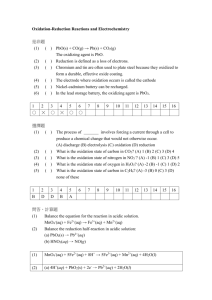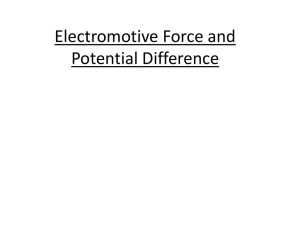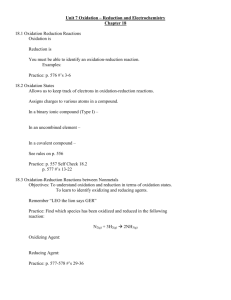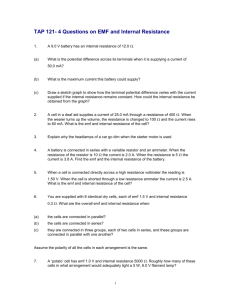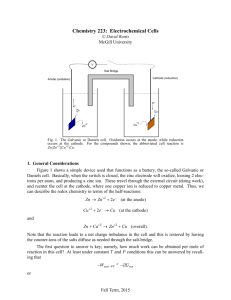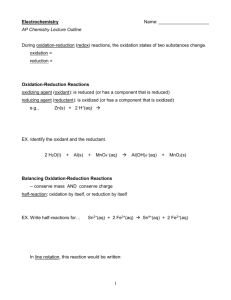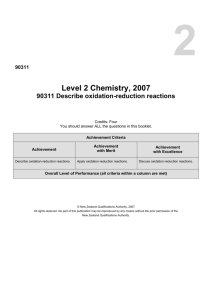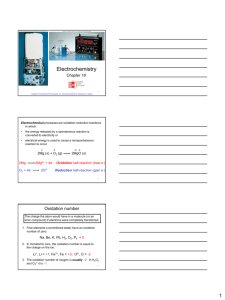StudentBluffersGuidech20
advertisement
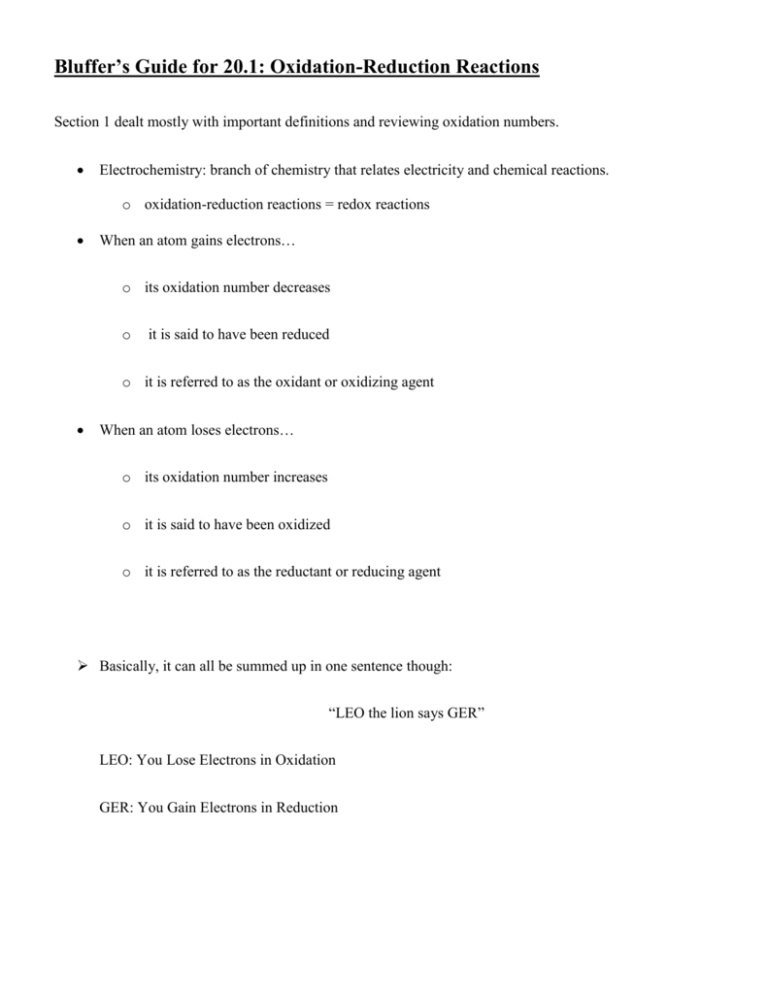
Bluffer’s Guide for 20.1: Oxidation-Reduction Reactions Section 1 dealt mostly with important definitions and reviewing oxidation numbers. Electrochemistry: branch of chemistry that relates electricity and chemical reactions. o oxidation-reduction reactions = redox reactions When an atom gains electrons… o its oxidation number decreases o it is said to have been reduced o it is referred to as the oxidant or oxidizing agent When an atom loses electrons… o its oxidation number increases o it is said to have been oxidized o it is referred to as the reductant or reducing agent Basically, it can all be summed up in one sentence though: “LEO the lion says GER” LEO: You Lose Electrons in Oxidation GER: You Gain Electrons in Reduction Bluffer’s Guide 20.2 Balancing Oxidation-Reduction Equations Half reactions o Redox equation broken down to two equations o Oxidation and reduction equations Balance each half Balance O by adding water Balance H by adding H+ Balance charges Simplify MnO4-(aq) + C2O42-(aq) → Mn2+(aq) + CO2(aq) o MnO4-(aq) → Mn2+(aq), C2O42-(aq) → CO2(g) o MnO4-(aq) → Mn2+(aq) + 4H2O(l), C2O42-(aq) → 2CO2(g) o 8H+(aq) + MnO4-(aq) → Mn2+(aq) + 4H2O(l) o 5e- + 8H+(aq) + MnO4-(aq) → Mn2+(aq) + 4H2O(l), C2O42-(aq) → 2CO2(g) + 2e- o 16H+(aq) + 2MnO4-(aq) + 5C2O42-(aq) → 2Mn2+(aq) + 8H2O(l) + 10CO2(g) Bluffer's Guide Chapter 20, section 4 Emf o Chemical processes in voltaic cells are spontaneous Electrons flow from anode to cathode because of difference in potential energy This difference – measured in volts (V) 1 V = 1J/1C (Joules/Coulomb) o This driving force called electromotive force (emf) Emf of a cell – cell potential – denoted Ecell Under standard conditions (298k, 1 atm, 1M concentrations), called standard emf Also, standard cell potential Denoted E°cell Standard Reduction Potentials o Each half cell – assigned a standard potential No need for tabulation every possible combination of anode, cathode Cell potential – difference between these two potentials Convention – standard potentials in terms of reduction o Standard reduction potentials Denoted E°red E°cell = E°red (cathode) - E°cell (anode) o Standard Hydrogen Electrode (SHE) Zero by which standard reduction potentials are calculated (E°red =0) Reduction of H+(aq) to H2(g) Consists of platinum immersed in 1M strong acid with H2 at 1 atm pressure above the reaction. o All half reactions written as reductions even if they "run in reverse" i.e., are oxidized e.g., zinc Produces a negative E°red (for zinc, -.763 V) o Problem solving tips Coefficients are ignored when calculating standard reduction potential Electric potential measured relative to charge, not stoiciometry Sign of E°red indicative of behavior The more positive E°red, the more likely reduction will occur The more negative E°red, the more likely oxidation will occur In any voltaic cell, the anode will have a lower E°red than the cathode Oxidizing and Reducing Agents o Standard reduction potentials may be applied outside of voltaic cells o The larger (more positive) E°red, the stronger the oxidizing agent o The smaller (more negative) E°red, the stronger the reducing agent o This is the basis for the activity series. Section 20.5 Spontaneity (spontininity) of reactions A Positive E value indicates a spontaneous process a negative E value indicates a nonspontaneous reaction It can also be determined by using Gibbs Free Energy The equation relates Volts and Joules by using Faraday’s constant which is 96500 Coulombs per mole or joules per mole volt because a positive E value will give a negative value for Gibbs Free energy Bluffer’s guide 20.6 Effects of concentration on cell EMF Since reactants are consumed and products are generated as the cell operates, the emf progressively drops until E=0. When this occur the cell is referred to as dead. To find the emf under these nonstandard conditions the Nernst equation must be used. E E RT ln Q nF As a general rule as reactants increase relative to products emf increases. If products increase, emf decreases. Since Q is equal to the products over reactants this equation can be used to find E under non-standard conditions or the concentration of one of the species I na reaction of the concentration of the others are known. Concentration cells If a cell has the same species as an anode and cathode and the emf is solely dependant on the concentrations of the species, then the cell is called a concentration cell. The product is the dilute species while the concentrated species is the reactant. At equilibrium Since E=0 at equilibrium and ln K eq Q K eq The Nernst equation can be rewritten as nFE RT Section 20-9: Electrolysis Electrolysis Reactions occur when electrical energy is added to a system to produce a nonspontaneous reaction and occur in electrolytic cells. Electrodes in electrolytic cells are in solution or in a molten salt (salts that have a high melting point and that have the possibility of producing different products than the aqueous solution due to the lack of the H2O). Inert Electrodes- electrodes that do not undergo a chemical reaction, but serve as the surface where a oxidation-reduction reaction would occur. Active Electrodes- electrodes that undergo chemical reactions and participate in the electrolysis process. Electroplating- uses the process of electrolysis to produce a thin layer of a metal onto another metal in order to improve it. Stoichiometry is used to determine the number of moles of a metal it takes to reduce itself. Example: Na+ + eCu2+ + 2e- Na 1 mole of electrons will plate out of 1 mole of Na metal Cu 2 moles of electrons will plate out of Cu metal Coulombs are used to measure the quantity of a charge passing through an electrical circuit. Coulombs = amperes x seconds Electrical work can be calculated by: G = wmax wmax = -nFE A negative value of wmax means work will be done on the surroundings Eext is the external potential for a reaction. w = nFEext n x F = the total electrical charge forced into a system by the external potential. 1 Watt = 1 Joule per second

